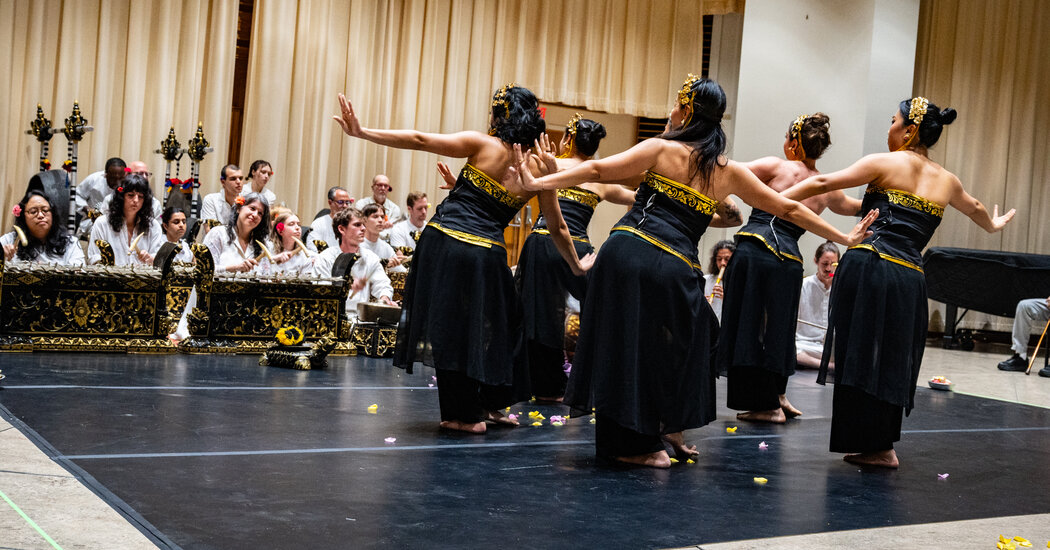On Mother’s Day in the main hall of the Ridgewood Presbyterian Church in Queens, a handful of members of Gamelan Dharma Swara, an ensemble that plays traditional and contemporary Balinese music, practiced its new piece, “Pagar Ayu.” It was a joyous cacophony — a melding of metallophones, other percussive instruments and flute — though it was still in need of refinement.
“You’re giving away some part of yourself to the people,” Victoria Lo Mellin, Dharma Swara’s president, directed the musicians. Lo Mellin, 38, who has been with the ensemble since 2007, tried to communicate a sense of urgency. The world premiere of “Pagar Ayu” — a moment to celebrate the group’s rebirth in the wake of the pandemic with a work created expressly for its members — was less than two weeks away.
There are more than 100 gamelan groups in the United States. Some perform the music and dance styles that developed on the Indonesian island on Bali; others take up those from the nearby islands of Java or Sunda. Some hew closely to the traditions rooted in gamelan’s 1,300-year history; others mix in, either subtly or liberally, Western and modern influences.
Dharma Swara is firmly situated in the Balinese branch of the music, which has a generally faster tempo — think wind chimes more often caught up in a glorious gale than riding a contemplative breeze — and uses fewer gongs and more gangsa, a type of ornate bamboo-and-brass metallophone with keys that are suspended above the instrument’s body. But as much as the members embrace gamelan and its origins, they are also mindful of their own.
“We have a personality that’s uniquely American. It’s innately American,” Lo Mellin said.
Establishing an identity that is distinct, authentic and respectful has been Dharma Swara’s ongoing quest for more than a decade. After preparing for and performing at the 2010 Bali Arts Festival, the first time a Western ensemble had been invited to Indonesia to participate in the yearly celebration of Balinese culture, members started to ask themselves what else they could achieve.
“The 2010s were such an interesting inflection point for the group,” Lo Mellin said.
In 2013, Dharma Swara parted ways with the Indonesian consulate, which had supported the ensemble since its founding in 1989. This independence allowed the members to shed some constraints of what was expected from a Balinese ensemble and to bring gamelan to wider audiences, as the group did at the music festival Basilica Soundscape in 2014, when it opened for the experimental bands Deafheaven and Swans. However, that freedom also required the group to find funding for a practice space and its own set of instruments, which arrived from Bali in 2017.
All the gains that the ensemble made over those years were nearly eradicated by the pandemic. By 2022, several members had moved on; the instruments were in storage after the practice space had been shuttered. Lo Mellin, who gave birth to twins in June 2020, almost walked away herself, but then had a change of heart.
“It was me and Miranda,” Lo Mellin said, referring to the group’s head dance coordinator, Miranda Danusugondo, 52. “We were like, ‘We’re going to keep this thing alive.’”
Once Lo Mellin found the practice space at the church in Ridgewood, Dharma Swara’s resurrection began. She has since rebuilt membership through community workshops, which are held twice a year, and the ensemble has rebounded to an ideal of nearly 30 musicians and dancers.
May has been a whirlwind for the group. Its engagements started with a performance at the Brooklyn Museum’s First Saturday program, and end on Saturday at 5 p.m. with the official world premiere of “Pagar Ayu” at Hunters Point Park in Long Island City, Queens.
Composed by the group’s artist-in-residence, Gusti Komin, and choreographed by Shoko Yamamuro, a former member, the piece is a welcome dance, intended to greet the audience and ask the spirits to inhabit the instruments and inspire the musicians and dancers during the performance. The choreography, set in a gender-neutral style, is not traditionally Balinese, Danusugondo emphasized. It is a piece for gamelan, she said, “and specifically for us.” Yamamuro used her knowledge of Balinese dance to inform the moves, but “it’s just her movement as inspired by the music” and “what it means to be in New York,” Danusugondo said.
To prepare for the debut of “Pagar Ayu,” the members participated in a three-day retreat at the Chautauqua Institution in upstate New York that wrapped up on Tuesday evening. At this gamelan band camp of sorts, the musicians and dancers practiced six to eight hours daily and deepened their knowledge of Balinese culture through films and discussions.
But the ultimate goal was to create a “familan,” Lo Mellin said, to foster tighter bonds that cannot be achieved during the ensemble’s rehearsals. That connection will help the musicians to be present, give their all and inhabit “the energy everybody should feel,” she said.
As Danusugondo observed during the Mother’s Day rehearsal: “A great gamelan performance comes together when the members fully immerse themselves in the moment.”
